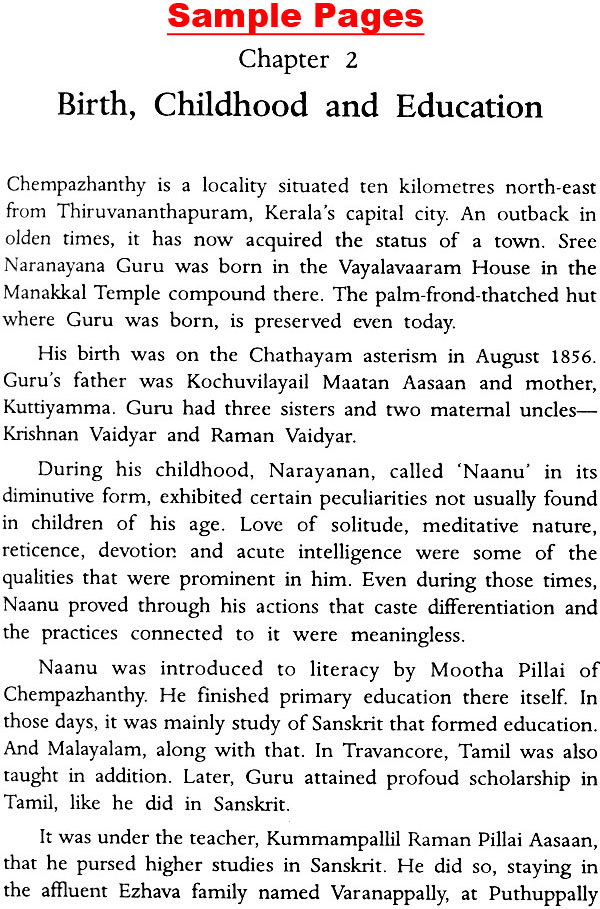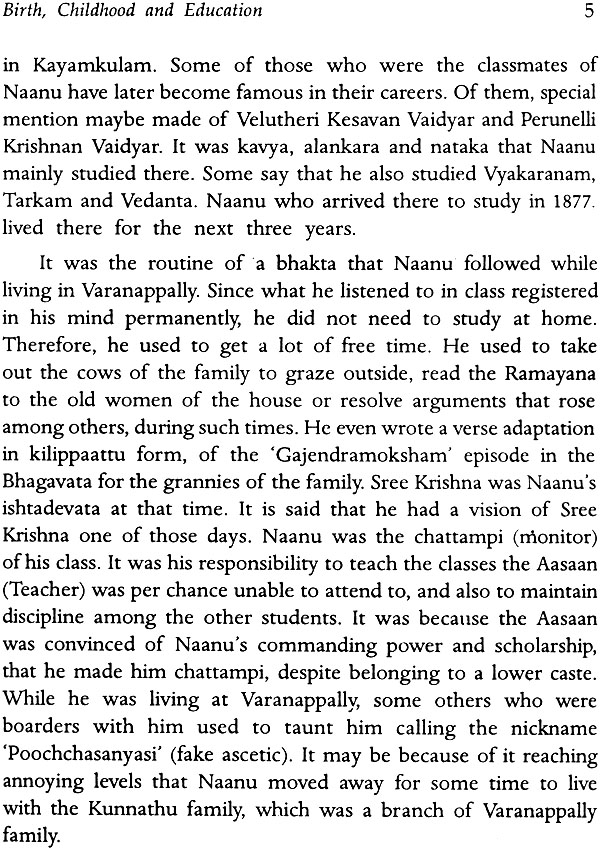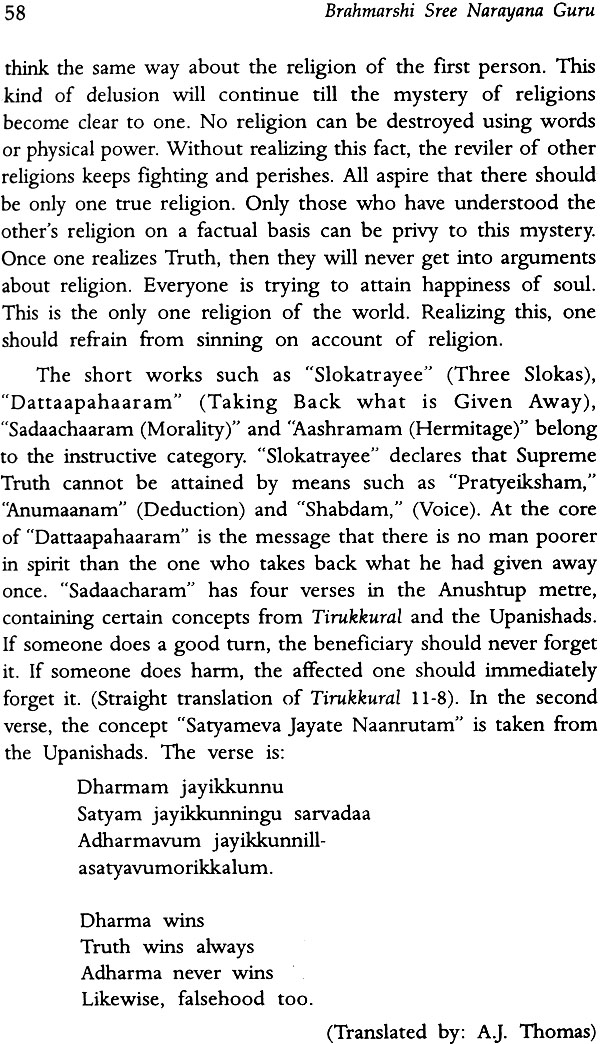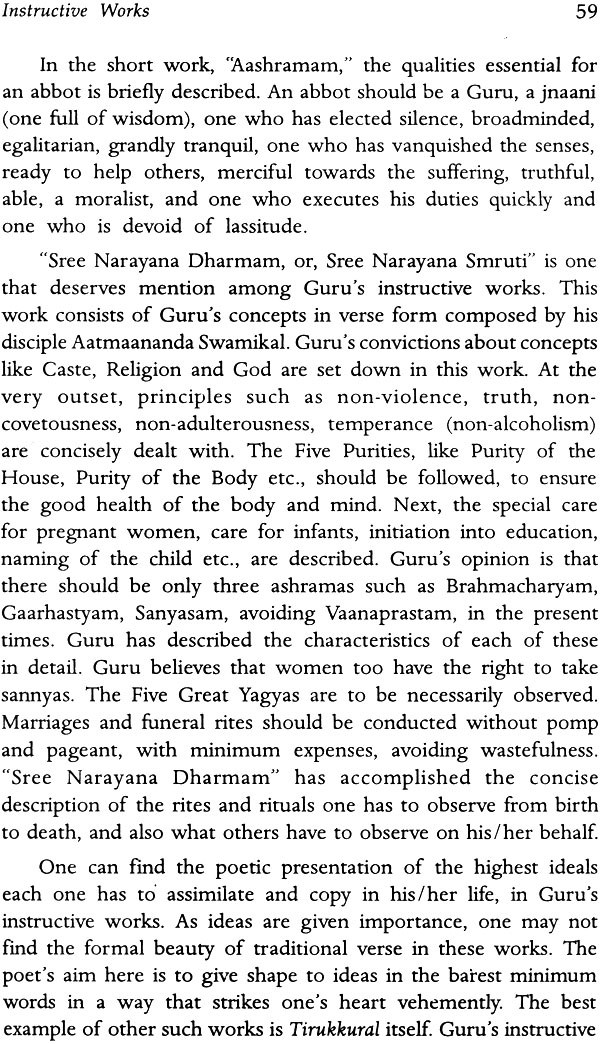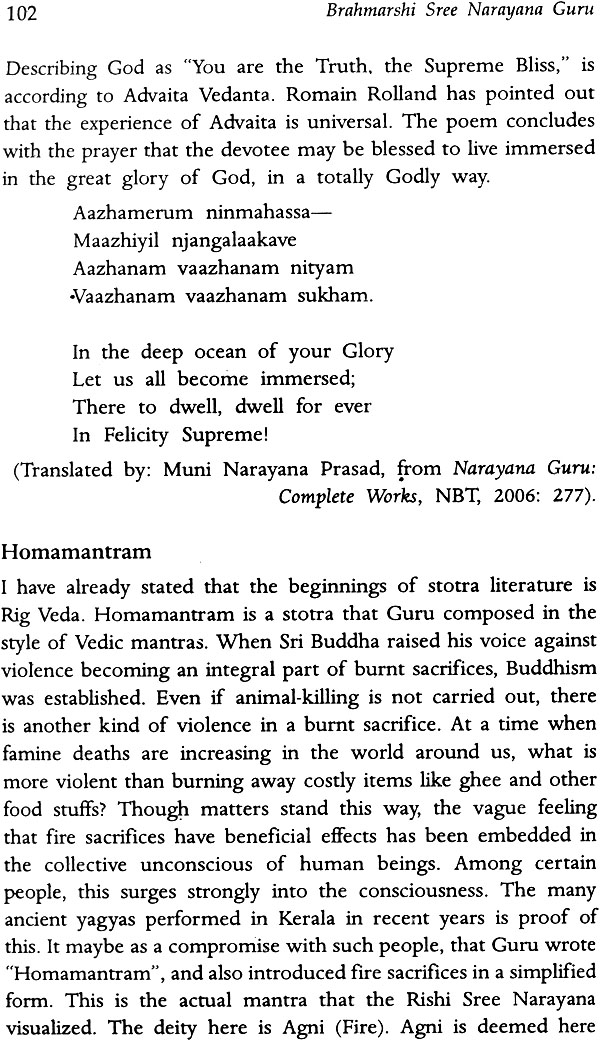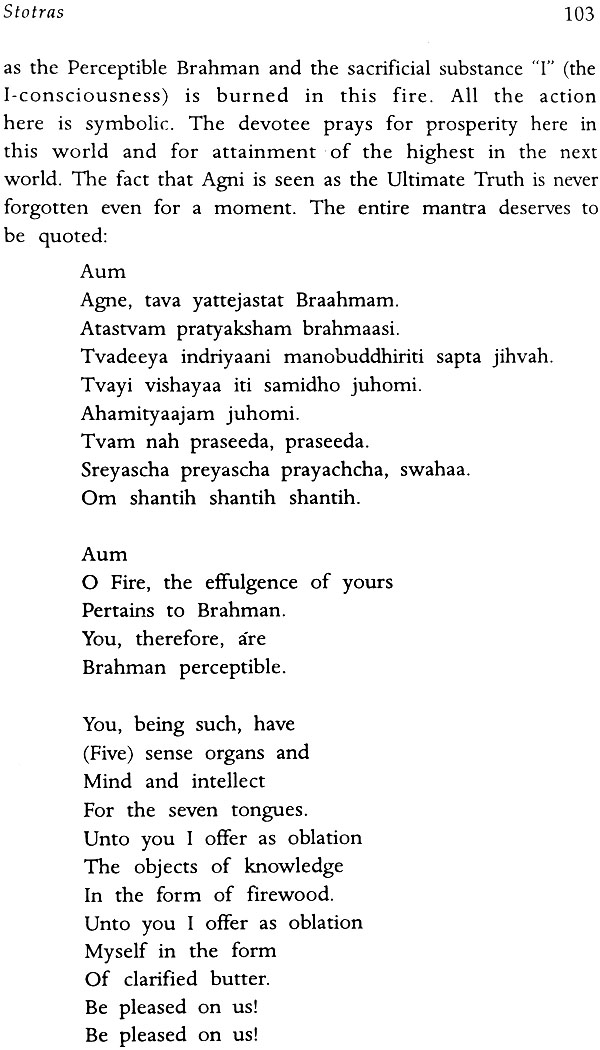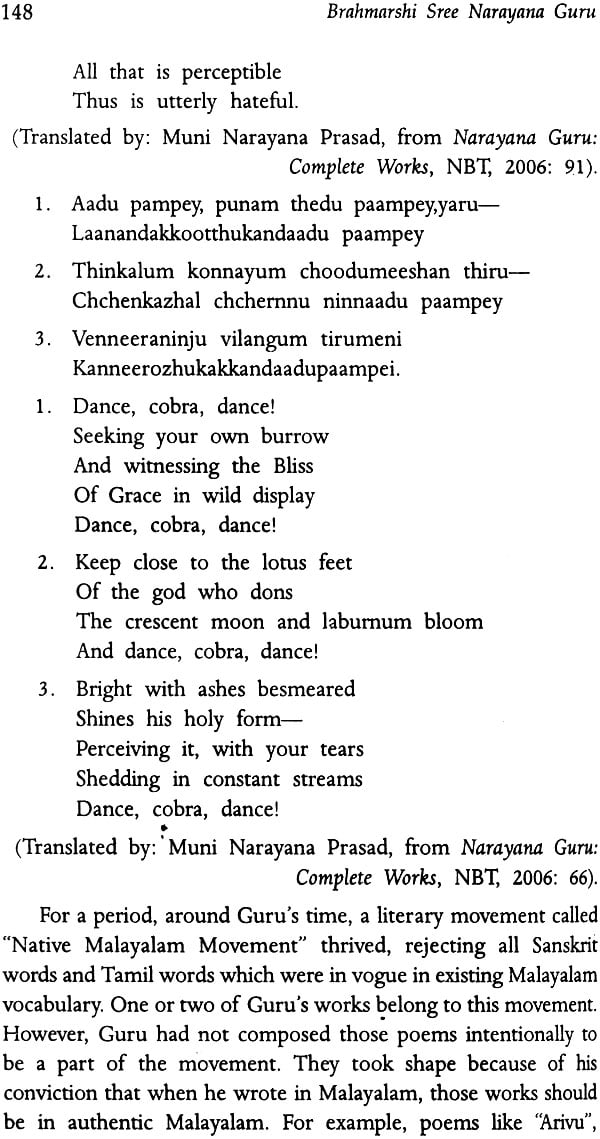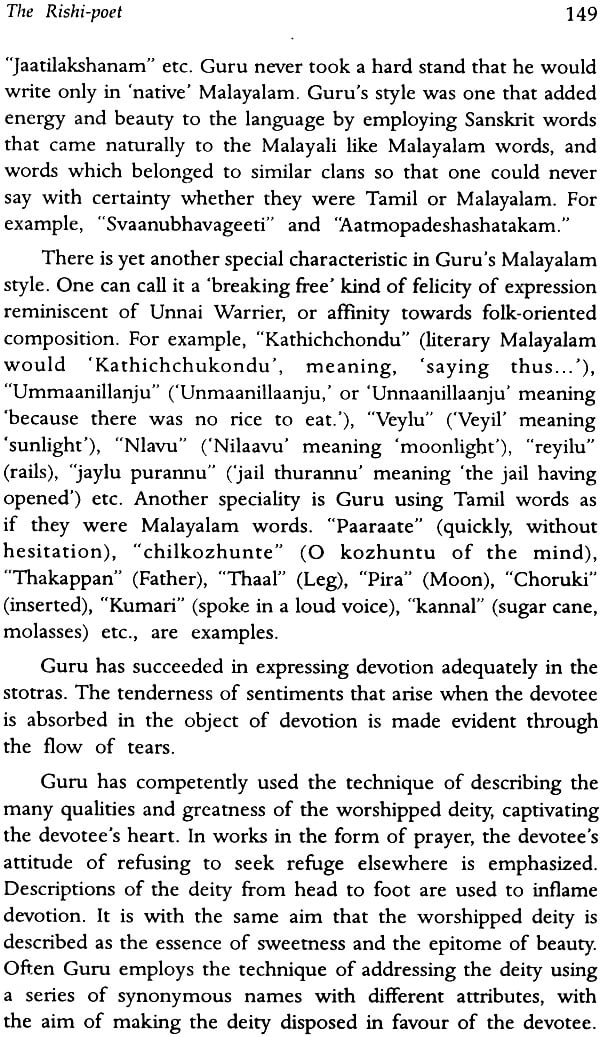
Brahmarshi Sree Narayana Guru (Makers of Indian Literature)
Book Specification
| Item Code: | NAK271 |
| Author: | T. Bhaskaran Translated by A. J. Thomas |
| Publisher: | SAHITYA AKADEMI, DELHI |
| Language: | English |
| Edition: | 2016 |
| ISBN: | 9788126047611 |
| Pages: | 180 |
| Cover: | Paperback |
| Other Details | 8.5 inch X 5.5 inch |
| Weight | 250 gm |
Book Description
Brahmarshi Sree Narayana Guru (1856-1928) was a great Indian seer who straddled the 19th and 20th centuries. It was Guru's pioneering work that became the foundation for the far-reaching and positive changes in the social, cultural, economic and educational spheres in Kerala. He was also an erudite scholar of Sanskrit, Malayalam and Tamil. He was an indigenous contributor to the great Indian philosophical tradition of Advaita. As the force behind a social reform movement that sought to sweep away caste differences and untouchability, Guru is undoubtedly the pioneer who levelled the ground for a progressive society with high levels of human development we see in Kerala today. This short monograph will surely give a valuable glimpse into this great soul's life and literary contributions that helped shape the literature of modern India.
T. Bhaskaran (born 1929) who has written this biography of Guru is a post-graduate and Ph D holder in Sanskrit and Malayalam. Professor Bhaskaran who has taught Sanskrit and Malayalam in several colleges and universities, is also the author of several literature-related works. He has published commentaries of all of Guru's literary works, and also two books Maharshi Sree Narayana Guru and Brahmajnanaaya Sree Narayana Guru (Sree Narayana Guru Who Has Attained the Knowledge of Brahman). He is the author of many other works and the editor of many more.
A.J. Thomas (b.1952) is an Indian English poet, fiction writer and translator. A former Editor of Indian Literature, he was also a Senior Consultant at IGNOU and an English Faculty member of Benghazi University, Libya. Has several books to his credit including Germination (Poetry, 1989), Aagami Pal Ka Nirman (His poetry in Hindi translation- 2010), and anthology appearances in The Literary Review Indian Poetry (USA-2009), The Harper Collins Book of English Poetry (2012), The Dance of the Peacock (Poetry-2013 , Hidden Brook Press, Canada), Marginalised: India Poetry in English (Rodopi International, Amsterdam-2013), and major woks of translation of poetry, fiction and drama. Recipient of several prestigious awards, including the Crossword Award.
It is the curse of India, especially of Kerala, that such a situation as described above, was created. In the case of Kerala at least, it was Brahmarshi Sree Narayana Guru who redeemed people from this curse, to a great extent. The main instrument in this was Guru's power that proceeded from the energy of his immense penance. The means he employed in this were completely non-violent and compassion-filled. Even when facing opaque conservatism, he maintained perfect balance of mind and viewed the opposing standpoints with complete sympathy.' Guru was prepared to wait for any length of time for social changes that could be attained through change of mentalities. When the Tiyyas disagreed to grant entry into temples which the Guru had built for them, to people whom they viewed as untouchables, Guru brought around such people step by step, and finally got them to agree to grant entry to all. Guru knew that only such changes would be permanent.
Guru's contribution to literature is considerable. The reforms he brought into the social sphere are wholesome and durable. Thus the importance of publishing the story of Guru's life in the series Makers of Indian Literature is self-evident.
The Upanishads declare that one who has attained knowledge of Brahman is Brahman Himself. Rishi is the one who has realized Truth. Guru has realized the Truth that is Brahman. That is why I have qualified Sree Narayana Guru as 'Brahrnarshi.'
His composition of "Vedantasutram" and "Homamantram" supports this honorific. Only from the heart of a Rishi can "Daivadashakam" and 'Aatmopadeshashatakam'' can proceed. Jata, vatkala and yogadandu are merely the external signs of a Rishi. It is only Jnana that makes a Rishi what he is.
"Homamantram" which begins, 'Om Agne tava yattejah' is a very specially original mantra. Hence, I do not find any discrepancy in calling Guru, 'Rishi', 'Maharshi' or 'Brahmarshi.'
I am grateful to Professor M. Thomas Mathew who read the manuscript of this book and made suggestions for improvement. I am thankful to all those, named and unnamed, whose works I have relied on, for writing this book.
CONTENTS
| Preface | vii | |
| 1 | Historical Background | 1 |
| 2 | Birth, Childhood and Education | 4 |
| 3 | Naanu Aasaan | 6 |
| 4 | Yoga and Penance | 8 |
| 5 | Ezhava Shiva | 10 |
| 6 | Two Great Organizations | 13 |
| 7 | Temples and Ancillary Establishments | 18 |
| 8 | Other Important Events | 21 |
| 9 | Messages and Conversations | 27 |
| 10 | Guru and Kerala's Poetic Tradition | 29 |
| 11 | Translations | 35 |
| 12 | Prose Works | 44 |
| 13 | Instructive Works | 51 |
| 14 | Stotras | 61 |
| 15 | Philosophical Works | 105 |
| 16 | The Rishi-poet | 136 |
| 17 | Guru's Poetic Ideal | 153 |
| 18 | Conclusion | 159 |
| Works of Sree Narayana Guru | 162 | |
| Bibliography | 165 |
